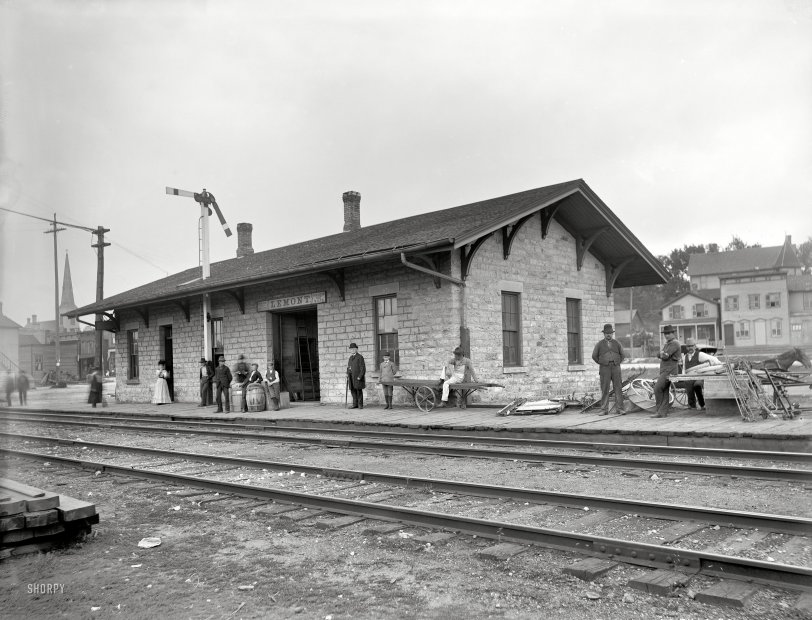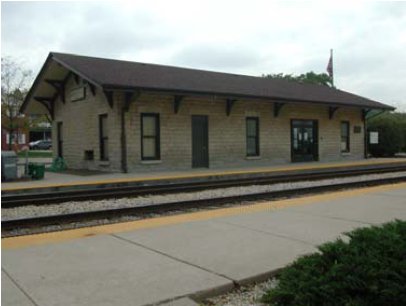


Framed or unframed, desk size to sofa size, printed by us in Arizona and Alabama since 2007. Explore now.
Shorpy is funded by you. Patreon contributors get an ad-free experience.
Learn more.

- Freeze Frame
- Texas Flyer wanted
- Just a Year Too Soon
- WWII -- Replacing men with women at the railroad crossing.
- Yes, Icing
- You kids drive me nuts!
- NOT An Easy Job
- I wonder
- Just add window boxes
- Icing Platform?
- Indiana Harbor Belt abides
- Freezing haze
- Corrections (for those who care)
- C&NW at Nelson
- Fallen Flags
- A dangerous job made worse
- Water Stop
- Passenger trains have right of way over freights?
- Coal
- Never ceases to amaze me.
- Still chuggin' (in model form)
- Great shot
- Westerly Breeze
- For the men, a trapeze
- Tickled
- Sense of loneliness ...
- 2 cents
- Charm City
- What an Outrage
- Brighton Park
Print Emporium
Lemont Depot: 1902

Lemont, Illinois, circa 1902. "Station of the Chicago & Alton R.R. Taken from Canal Street." 8x10 glass negative, Detroit Publishing Co. View full size.
Roman collars and train wrecks
Some Catholic priests wear that kind of collar. There's no doctrinal significance to the variations. Derby hat: no doctrinal significance there either. A. H. Malan (1852-1928) was an English clergyman who documented a great deal of the Great Western Railway's broad gauge days with his camera.
Those rail joints have bond wires on them. Automatic block signals, or an interlocking, or switch indicators?
I worked on a manual block railroad years ago, and we had a wreck that was mitigated by switch indicators. These are signals governed by the position of switches. Two freights were opposing each other on the single track main. When the first freight passed the switch indicator, it dropped the signal in front the second. They still collided, but it wasn't as bad.
Lincoln's Funeral Train passed here
This is the oldest station in the Chicago commuter rail system (Metra). It was in use when Lincoln's funeral train passed in 1865 (info from Metra historical records).
Clergymen and Depots
The depot is unusual in that, although the semaphore train order signal means this is a telegraph office, it has no bay window, which is where the operator sat with his apparatus.
Notice that although a modest depot, it is constructed of stone. A similar-sized depot down South would almost certainly have been wooden, despite the potential problems with humidity and termites. Southern railroads were so poor (or their Yankee owners were so cheap). It really took them almost 100 years to start recovering from The War.
The track structure is showing signs of modern evolution. Six-hole joint bars of a design that is basically still in use today. The longer the bar, the more holes for bolts, the stronger the joint between rails. In earlier Shorpy photos from the Civil War era, two-hole joint bars were in use. But, the track engineers had not yet discovered the advantage of alternating the direction of the bolts. They're all facing the same way. And no tie plates or anchors yet, either.
And notice the old clergyman standing on the platform. He HAS to be an Episcopalian. That's an "Anglican collar" he's wearing. An "RC collar" had the black band around the outside of the white band, with a gap in the front. And, his overall dress doesn't appear to me to fit the usual RC style, especially the derby. Anglican clergymen are notorious train buffs, especially about steam engines. He doesn't have any baggage, so he's probably just down there to watch trains. The great BBC series, "Yes, Prime Minister" had an episode in which Sir Humphrey (Nigel Hawthorne) urged a candidate for bishop upon the PM, because even though he doubted the divinity of Christ, he LOVED steam engines.
Still there!
Those buildings must have been built to last!
Church in the Distance
The existing Lemont Station at 101 Main is the village’s first depot, dating from 1858. The station, built by the Chicago and Alton Railroad, was essential to the postcanal development of the Lemont Historic District. According to Ira J. Bach and Susan Wolfson in their book, A Guide to Chicago Train Stations, Present and Past, the Lemont depot is the oldest surviving masonry depot in the Chicago area
It appears as if the church that is shown in the distance is also still standing on E Illinois St near State St.

























On Shorpy:
Today’s Top 5